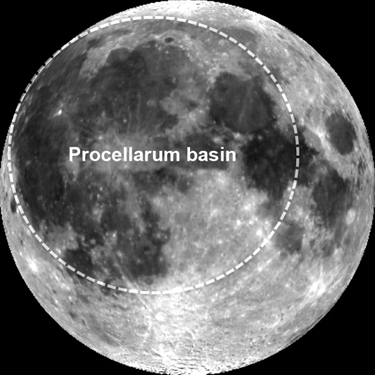
The moon's Procellarum basin, the dark part as seen from Earth, is what remains of the impact crater, they said. Its vast size is apparent in relation to the moon's diameter: 3,476 km. (The basin is likened in Japanese folklore to the shape of a rabbit pounding rice cakes.)
The research team from the National Institute of Advanced Industrial Science and Technology (AIST) in Tsukuba and other institutions was headed by the institute's Ryosuke Nakamura. It studied the distribution of minerals in mapping data obtained by the Kaguya moon exploration orbiters, satellites which are internationally known as Selene.
The researchers analyzed light reflection data recorded by Kaguya at 70 million locations across the moon's surface. They concluded that one of the minerals present is low-calcium pyroxene, likely generated when rock melted under the heat of an impact, and that the mineral is concentrated in a near-circle around the Procellarum basin.
The scientists believe an asteroid of more than 300 km in diameter hit the moon some 3.9 billion years ago, leaving a crater and melting much of the moon's rock under the energy of the impact.
But subsequent impacts by smaller asteroids shifted the topography further, making it difficult now to determine whether the basin is what remains of a major impact.
The side of the moon that faces Earth has many flat and dark regions known as "maria," the Latin word for "seas." The far side of the moon has higher elevations and a thicker crust.
"The latest study explains why the moon's two sides are so different," said Junichi Watanabe, a professor of astronomy at the National Astronomical Observatory of Japan. "It helps unravel the mystery of the moon's history."
The research results were published online Oct. 28 in Nature Geoscience, a British scientific journal.



Reader Comments
to our Newsletter